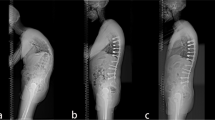Abstract
Kyphosis is a common sequel of inadequately managed thoracolumbar fractures. This study compares between pedicle subtraction osteotomy (PSO) and anterior corpectomy and plating (ACP) for correcting post-traumatic kyphosis. Forty-three patients with symptomatic post-traumatic kyphosis of the thoracolumbar spine were treated with PSO and prospectively followed for a minimum of 2 years. Visual Analogue Scale (VAS) and Oswestry Disability Index (ODI) were used to assess clinical improvement and radiographs were obtained at 2, 6, 12 and 24 months. The recorded clinical and radiological outcomes were compared to a control group of 37 patients, who were treated earlier by the same authors with ACP. The mean correction of the kyphotic angle was 29.8° for the PSO group and 22° for the ACP group (P = 0.001). PSO group showed significantly better improvement in the VAS score and the ODI. At final follow-up, patients reported very good satisfaction (93% in PSO vs. 81% in ACP) and good function (90% in PSO vs. 73% in ACP). Complications in the PSO group included pulling out of screws and recurrence of deformity requiring revision and longer fixation (1 patient), and transient lower limb paraesthesia (2 patients). Recorded complications in the ACP group included an aortic injury (1 patient) that was successfully repaired, pseudarthrosis (1 patient), persistent graft donor site morbidity (3 patients), and incisional hernia (1 patient). PSO and ACP are demanding procedures. PSO seems to be equally safe but more effective than ACP for correcting post-traumatic kyphosis.





Similar content being viewed by others
References
Roberson JR, Whitesides TE (1985) Surgical reconstruction of late post-traumatic thoracolumbar kyphosis. Spine 10:307–312
Gertzbein SD, Harris MB (1992) Wedge osteotomy for the correction of posttraumatic kyphosis: a new technique and a report of three cases. Spine 17:374–379
Malcolm BW, Bradford DS, Winter RB, Chou SN (1981) Post-traumatic kyphosis: a review of forty-eight surgically treated patients. J Bone Joint Surg Am 63:891–899
Kostuik JP, Matsusaki H (1989) Anterior stabilization instrumentation, and decompression for post-traumatic kyphosis. Spine 14:379–386
Oda I, Cunningham BW, Buckley RA, Goebel MJ, Haggerty CJ, Orbegoso CM, McAfee PC (1999) Does spinal kyphotic deformity influence the biomechanical characteristics of the adjacent motion segments? An in vivo animal model. Spine 24:2139–2146
Dietrich M, Kurowski P (1985) The importance of mechanical factors in the etiology of spondylolysis: a model analysis of loads and stresses in human lumbar spine. Spine 10:532–542
Kostuik JP (1990) Anterior Kostuik–Harrington distraction system for the treatment of kyphotic deformities. Spine 15:169–180
Illes T, de Jonge T, Doman I, Doczi T (2002) Surgical correction of the late consequences of post-traumatic spinal disorders. J Spinal Disord Tech 15:127–132
Stoltze D, Harms J (1999) Correction of post-traumatic deformities: principles and methods. Orthopäde 28:731–745
Suk SI, Kim JH, Lee SM, Chung ER, Lee JH (2003) Anterior–posterior surgery versus posterior closing wedge osteotomy in posttraumatic kyphosis with neurologic compromised osteoporotic fracture. Spine 28:2170–2175
Eysel P, Hopf C, Furderer S (2001) Kyphotic deformation in fractures of the thoracic and lumbar spine. Orthopäde 30:355–364
Kaneda K (1991) Anterior approach and Kaneda instrumentation for lesions of the thoracic and lumbar spine. In: Bridwell KH, DeWald RL (eds) The textbook of spinal surgery. Lippincott, Philadelphia, pp 959–990
Benli T, Kaya A, Uruc V, Akalin S (2007) Minimum 5-year follow-up surgical results of post-traumatic thoracic and lumbar kyphosis treated with anterior instrumentation comparison of anterior plate and dual rod systems. Spine 9:986–994
Been HD, Poolman RW, Ubags LH (2004) Clinical outcome and radiographic results after surgical treatment of post-traumatic thoracolumbar kyphosis. Eur Spine J 13:101–107
Berven SH, Deviren V, Smith JA, Emami A, Hu SS, Bradford DS (2001) Management of fixed sagittal plane deformity: results of the transpedicular wedge resection osteotomy. Spine 26:2036–2043
Bridwell KH, Lewis SJ, Lenke LG, Baldus C, Blanke K (2003) Pedicle subtraction osteotomy for the treatment of fixed sagittal imbalance. J Bone Joint Surg Am 85:454–463
Bridwell KH, Lewis SJ, Edwards C, Lenke LG, Iffrig TM, Berra A, Baldus C, Blanke K (2003) Complications and outcomes of pedicle subtraction osteotomies for fixed sagittal imbalance. Spine 28:2093–2101
Bridwell KH, Lewis SJ, Rinella A, Lenke LG, Baldus C, Blanke K (2004) Pedicle subtraction osteotomy for the treatment of fixed sagittal imbalance. Surgical technique. J Bone Joint Surg Am 86(Suppl 1):44–50
Yang BP, Ondra SL, Chen LA, Jung HS, Koski TR, Salehi SA (2006) Clinical and radiographic outcomes of thoracic and lumbar pedicle subtraction osteotomy for fixed sagittal imbalance. J Neurosurg Spine 5:9–17
Kim YJ, Bridwell KH, Lenke LG, Cheh G, Baldus C (2007) Results of lumbar pedicle subtraction osteotomies for fixed sagittal imbalance: a minimum 5-year follow-up study. Spine 32:2189–2197
Buchowski JM, Kuhns CA, Bridwell KH, Lenke LG (2008) Surgical management of posttraumatic thoracolumbar kyphosis. Spine J 8:666–677
Wu SS, Hwa SY, Lin LC, Pai WM, Chen PQ, Au MK (1996) Management of rigid post-traumatic kyphosis. Spine 19:2260–2266
Lazennec JY, Neves N, Rousseau MA, Boyer P, Mousselard HP, Saillant G (2006) Wedge osteotomy for treating post-traumatic kyphosis at thoracolumbar and lumbar levels. J Spinal Disord Tech 19:487–494
Berven S, Deviren V, Smith J, Hu S, Bradford D (2003) Management of fixed sagittal plane deformity: outcome of combined anterior and posterior surgery. Spine 15:1710–1716
Oskouian RJ Jr, Johnson JP (2002) Vascular complications in anterior thoracolumbar spinal reconstruction. J Neurosurg 96(1 Suppl):1–5
Kim YB, Lenke LG, Kim YJ, Kim YW, Blanke K, Stobbs G, Bridwell KH (2009) The morbidity of an anterior thoracolumbar approach: adult spinal deformity patients with greater than five-year follow-up. Spine 34:822–826
Munting E (2010) Surgical treatment of post-traumatic kyphosis in the thoracolumbar spine: indications and technical aspects. Eur Spine J 19(Suppl 1):S69–S73
Conflict of interest
None.
Author information
Authors and Affiliations
Corresponding author
Rights and permissions
About this article
Cite this article
El-Sharkawi, M.M., Koptan, W.M.T., El-Miligui, Y.H. et al. Comparison between pedicle subtraction osteotomy and anterior corpectomy and plating for correcting post-traumatic kyphosis: a multicenter study. Eur Spine J 20, 1434–1440 (2011). https://doi.org/10.1007/s00586-011-1720-y
Received:
Revised:
Accepted:
Published:
Issue Date:
DOI: https://doi.org/10.1007/s00586-011-1720-y




